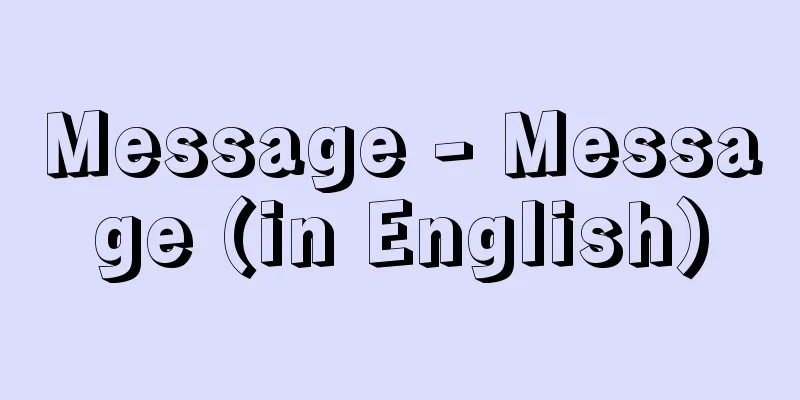Message - Message (in English)

|
A message is a symbol or a series of symbols that contains to some degree the purpose or intention of the sender. A message can therefore generally be said to be a meaningful communication content that is transmitted from one sender (originator) to another receiver (receiver), often overtly and sometimes informally. In order to transmit something, the content must first be encoded, and on the other hand, the encoded content must be translated back into its original meaning through decoding. It is important not to understand a message statically as a symbol transmitted from sender to receiver, or as a symbolic composition, but to understand it dynamically in the context of the interaction between the sender (producer) and receiver (decoder) of the symbol. The transmission and acceptance of the meaning contained in a message are determined by various variables or factors that mediate the communication process, but the social and cultural values shared between the sender and receiver are the decisive factors. The reactions and understanding of meanings of a particular message by people of the same culture are generally homogeneous and common, while the reactions and understanding of meanings of people of different cultures vary widely. Furthermore, even among people who share the same culture, variations arise according to the differences in their subcultures. When people use the same symbol system and share the same code, the meaning of the message becomes homogenized and standardized. [Naoyuki Okada] [Reference] | |Source: Shogakukan Encyclopedia Nipponica About Encyclopedia Nipponica Information | Legend |
|
送り手の目的や意図をなんらかの程度において内包した記号あるいは一連の記号群をいう。したがってメッセージとは、一般に、ある送り手(発信者)から他の受け手(受信者)へ多くの場合顕示的に、ある場合には非公式に伝達される有意のコミュニケーション内容といってよい。ある事柄を伝達するためには、まず一方で、その内容を記号化しなければならないし、他方で、記号化されたものをふたたび元の意味内容に翻訳し直す解読化の作業が必要である。メッセージを単に送り手から受け手に伝達される記号、あるいは記号の構成物として静態的に理解するだけではなく、記号の送り手(生産者)と受け手(解読者)との相互作用の文脈のなかで動態的に理解することが重要である。メッセージの内包する意味の伝達と受容は、コミュニケーション過程に介在する多様な変数ないし要因に規定されるが、送り手と受け手との間に共有されている社会的・文化的価値が決定的要因となる。同一文化を共有する人々の特定メッセージへの反応や意味理解は、一般に同質的で共通しており、他方、異文化に属する人々の反応や意味理解には多様な差異が派生する。さらに、同一文化を共有する人々の間でも、その下位文化(サブカルチャー)の相違に応じてバリエーションが生まれる。同じ記号体系を用い、同じコードを共有するとき、メッセージの意味内容は同質化し、規格化されるということにほかならない。 [岡田直之] [参照項目] | |出典 小学館 日本大百科全書(ニッポニカ)日本大百科全書(ニッポニカ)について 情報 | 凡例 |
<<: Messenia - Messenia (English spelling)
Recommend
Electric conductivity
...If the potential difference is V , the length ...
Otsu Gaiters - Otsukahan
〘Noun〙 Gaiters made in Otsu, Omi Province (Shiga P...
Wilson, K.
...The company's headquarters are in Memphis,...
Goshogawara [city] - Goshogawara
A city in the west of Aomori Prefecture, spreading...
Streamline - Ryusen
A curved line in a flow, the tangent of which at ...
Eckhart - Meister Johannes Eckhart
A medieval German mystic thinker. Born in central...
promenade concerts
…A shady promenade is called a mall, but this is ...
Matsuoka Komakichi
Labor activist and politician. Born in Tottori Pr...
Eugene Festival - Eugene Festival
…Something equivalent to this can be seen in the ...
Oxirane
[ I ] [Synonym] Ethylene oxide [ II ] A general t...
Partition wall - Kaiheki
A wall that separates each dwelling unit in an apa...
Kineya Saburosuke
...A Nagauta song. Composed in 1861 (Bunkyu 1) by...
Miasa [village] - Miasa
A village in Kitaazumi County in northwest Nagano ...
Kara (Bulgaria) (English spelling) Kara
…the river that flows south from Bulgaria to Gree...
Uguisu mochi - Uguisu mochi
…It can be made from yellow soybeans as well as g...









